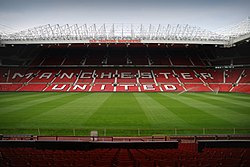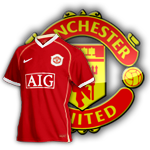-
Main article: Old Trafford
When the club was first founded, Newton Heath played their home games on a small field on North Road in Newton Heath, near to where Manchester Piccadilly Station is currently located. However, visiting teams often complained about the state of the pitch, which was "a bog at one end and rocky as a quarry at the other".[13] The changing rooms were also nothing to be proud of, being located ten minutes walk away at the Three Crowns pub on Oldham Road. They were later moved to the Shears Hotel, another pub on Oldham Road, but a change was needed if the club was to continue in the Football League.
The Heathens remained at their North Road ground for fifteen years from 1878 to 1893, a year after entering the Football League, before moving to a new home at Bank Street in nearby Clayton. The new ground was not much better, only a few tufts of grass sticking up through the sandy surface, and clouds of smoke coming down from the factory next door. On one occasion, the Walsall Town Swifts even refused to play, the conditions were so bad. A layer of sand was put down by the groundsman and the visitors were finally persuaded to play, eventually losing 14–0. They protested against the result, citing the poor conditions as the reason for their loss and the match was replayed. The conditions were not much better the second time around, and the Walsall team lost again, although this time they only lost 9–0.[13]
In 1902, the club went close to bankruptcy and the Bank Street ground was closed by bailiffs due to its insolvency. The club was saved at the last minute by captain Harry Stafford, who managed to scrape together enough money to pay for the club's next away game at Bristol City and found a temporary ground at neighbouring Harpurhey for the next home game against Blackpool.[54]
Following investment to get the club back on an even keel, they renamed as Manchester United, though still with a desire for a passable ground. Six weeks before United's first FA Cup title in April 1909, Old Trafford was named as the home of Manchester United, following the purchase of the necessary land for around £60,000. Architect Archibald Leitch was hired by United chairman John Henry Davies, and given a budget of £30,000 for construction. Original plans indicated that the stadium would hold around 100,000, though this was scaled back to 77,000. Despite this, a record attendance of 76,962 was recorded, which is more than even the current stadium officially supports. Construction was carried out by Messrs Brameld and Smith of Manchester. At the opening of the stadium, standing tickets cost sixpence, while the most expensive seats in the grandstand would have set you back five shillings. The inaugural game was played on 19 February 1910 against Liverpool F.C., and resulted in a 4–3 win for the visitors. As it happened, the change of ground could not have come soon enough. Only a few days after the club played their last game at Bank Street, the main stand was blown down in a storm.[55]
Bombing during the Second World War, on 11 March 1941, destroyed much of the stadium, notably the main stand. The central tunnel in the South Stand was all that remained of that quarter of the ground. Though the ground was rebuilt in 1949, it meant that a game had not been played at Old Trafford for nearly 10 years as the team played all their "home" games in that period at Manchester City's ground, Maine Road. Man City charged the club £5000 per year for the use of their stadium, plus a nominal percentage of the gate receipts. United filed a report with the War Damage Commission and received compensation to the value of £22,278 for the reconstruction of the ground.[56]
Subsequent improvements occurred, beginning with the addition of a roof first to the Stretford End and then to the North and East Stands. However, the old-fashioned roof supports obscured the view of many fans, resulting in the upgrading of the roofs to incorporate the cantilevering still seen on the stadium today. The Stretford End was the last stand to receive the upgrade to the cantilevered roof, the work being completed in time for the start of the 1993–94 season.[57]
Floodlights were first installed at the ground in the mid-1950s. Four 180-foot (55 m)-tall pylons were erected, each housing 54 individual floodlights. The whole lighting system cost the club £40,000, and was first used for a match on 25 March 1957. However, the old style floodlights were dismantled in 1987, to be replaced by a new lighting system embedded in the roof of each of the stands, which has survived to this day.
In 1990, following the Hillsborough Disaster, a report was issued which demanded all stadia must be all-seater stadia, leading to subsequent renovation, which dropped capacity to around 44,000. However, the club's popularity ensured that further development would occur. In 1995, the North Stand was redeveloped into three tiers, bringing the capacity up to approximately 55,000. This was followed by expansions of first the East and then West Stands to reach a total capacity of 68,000. The most recent expansion was completed in 2006, when the North-East and North-West Quadrants were opened, allowing the current record of 76,098, only 104 short of the stadium's maximum capacity.[57]
It has been estimated that for any further development to be attempted on the stadium, specifically the South Stand which is still only one tier high, development costs would almost equal the £114 million already spent on the stadium in the last fourteen years. This is due to the fact that up to fifty houses would have to be bought out by the club, which would cause a lot of disruption to local residents, and any extension would have to be built over the top of the railway line that runs adjacent to the stadium. Ideally, the expansion would include bringing the South Stand up to at least two tiers and filling in the South-West and South-East quadrants to restore the "bowl" effect of the stadium. Present estimates put the projected capacity of the completed stadium at approximately 96,000, more than the new Wembley Stadium.[57]










